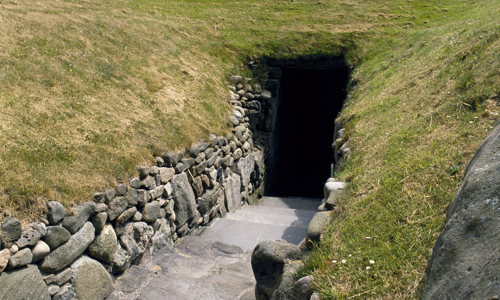History
Only one side of the Pictish cross-slab that once stood at Hilton of Cadboll Chapel has survived, but what’s there is remarkable.
The stone has a border of vinescroll inhabited by winged creatures – a design popular in Northumbria in the early medieval period. Three square panels sit within the border.
In the central panel we see an extraordinary hunting scene:
- the central figure is a horsewoman who wears a large brooch and rides side-saddle
- to her left are two Pictish symbols – a mirror and a comb
- behind her is another rider
- in the foreground, horsemen and hounds hunt for deer
It’s very rare to see a woman depicted in Pictish carvings, let alone in a central position. It’s possible this is a noble or royal scene.
Ups and downs
The cross-slab’s had a chequered history. Carved around AD 800, it soon apparently snapped at the tenon – the extension lodged in the ground to hold it upright - and toppled. It was re-erected, using the lower part of the stone as the tenon, and stood until 1674, when it broke again in a strong wind.
Two years later, one Alexander Duff had the stone reworked for use as a grave slab. The cross on one side was defaced and replaced by an inscription to Duff and his ‘three wives’.
The stone was given to the National Museum of Scotland in 1921, and can now be seen there in Edinburgh. A replica now stands on its original site close to Hilton of Cadboll Chapel.
A simple chapel
The remains of Hilton of Cadboll Chapel imply a simple, rectangular medieval chapel. There is a tradition of the site being used for the burial of unbaptised infants until the end of the 1800s. By 1856 the chapel was being used as a shed.
Today only the turfed footing of the chapel can be seen at the site, which passed into state care in 1978.














